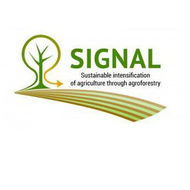Early response of soil fungal communities to the conversion of monoculture cropland to a temperate agroforestry system (2021.0)
Beule L., Karlovsky P.
PeerJ, 9 (), e12236
Abstract
Background Alley-cropping systems in the temperate zone are a type of agroforestry in which rows of fast-growing trees are alternated with rows of annual crops. With numerous environmental benefits, temperate agroforestry is considered a promising alternative to conventional agriculture and soil fungi may play a key in maintaining productivity of these systems. Agroforestry systems that are established for more than 10 years have shown to increase the fungal biomass and impact the composition of soil fungal communities. Investigations of soil fungi in younger temperate agroforestry systems are scarce and the temporal dynamic of these changes is not understood.Methods Our study was conducted in a young poplar-based alley cropping and adjacent monoculture cropland system in an Arenosol soil in north-west Germany. We investigated the temporal dynamics of fungal populations after the establishment of agroforestry by collecting soil samples half, one, and one and a half years after conversion of cropland to agroforestry. Samples were collected within the agroforestry tree row, at 1, 7, and 24 m distance from the tree row within the crop row, and in an adjacent conventional monoculture cropland. The biomass of soil fungi, Asco-, and Basidiomycota was determined by real-time PCR. Soil fungal community composition and diversity were obtained from amplicon sequencing. Results Differences in the community composition of soil fungi in the tree row and arable land were detected as early as half a year following the conversion of monoculture cropland to agroforestry. In the tree row, soil fungal communities in the plots strongly diverged with the age of the system. The presence of young trees did not affect the biomass of soil fungi. Conclusions The composition of soil fungal communities responded rapidly to the integration of trees into arable land through agroforestry, whereas the fungal biomass was not affected during the first one and a half years after planting the trees. Fungal communities under the trees gradually diversified. Adaptation to spatially heterogeneous belowground biomass of the trees and understory vegetation or stochastic phenomena due to limited exchange among fungal populations may account for this effect; long-term monitoring might help unravelling the cause.
